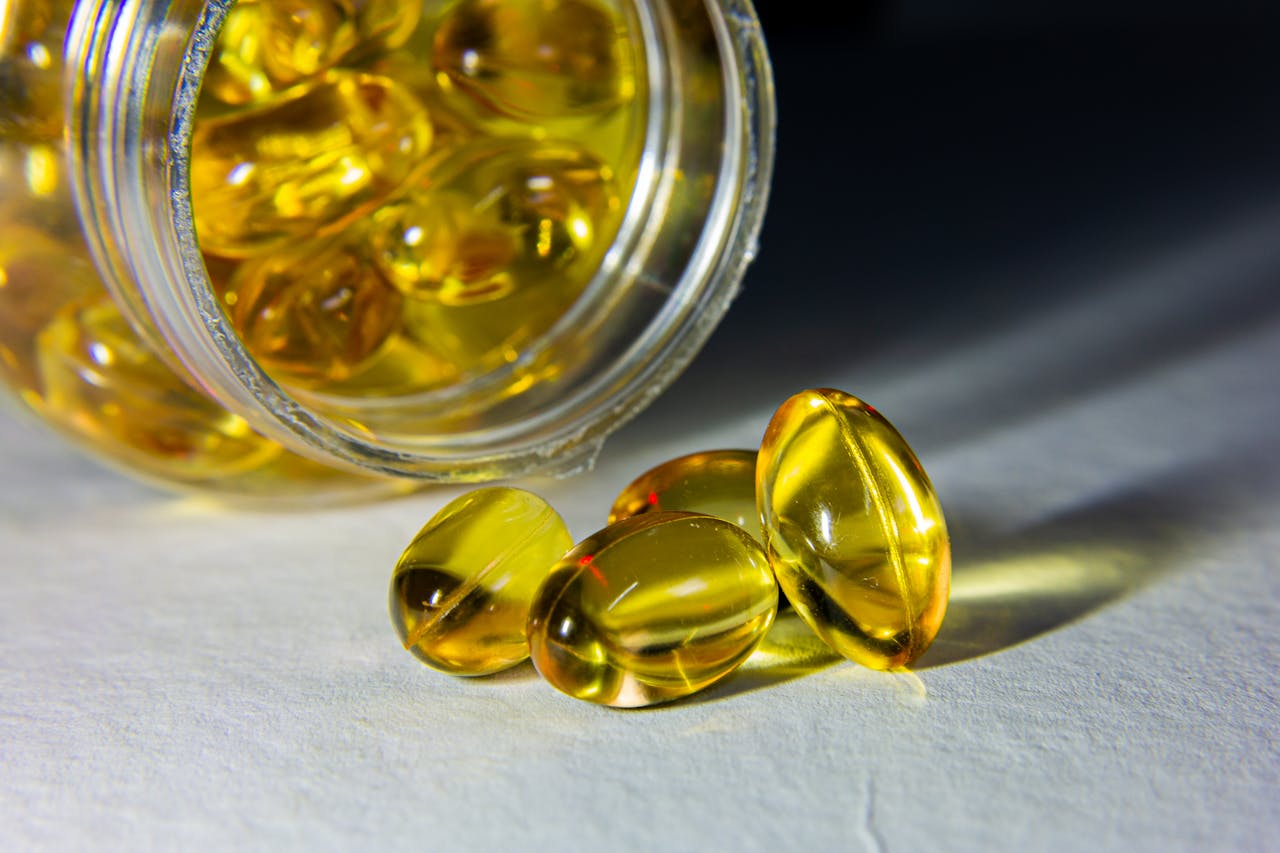1) Bone health: essential for deficiency, not a cure-all for everyone
Vitamin D helps your gut absorb calcium. If you’re deficient, bringing your level up supports bone mineralization and prevents bone diseases like rickets and osteomalacia—this hasn’t changed. The NIH’s professional fact sheet still anchors this as vitamin D’s most established role. Office of Dietary Supplements
What has changed is guidance on routine pills for fall/fracture prevention in community-dwelling older adults who aren’t deficient. In December 2024, the U.S. Preventive Services Task Force issued a draft recommendation against taking vitamin D (with or without calcium) to prevent falls or fractures in this group—no net benefit across a wide range of doses. (This does not apply if you have osteoporosis or a documented deficiency.) USPSTF+2USPSTF+2
Bottom line: If you’re low, correct it. But don’t expect an across-the-board fracture/fall shield from routine supplementation in otherwise replete older adults.
2) Immunity and respiratory infections: the story cooled off
Early meta-analyses hinted that vitamin D might reduce acute respiratory infections (ARIs). A major 2025 update in Lancet Diabetes & Endocrinology—pooling nearly 50 RCTs and ~60,000 participants—found no statistically significant overall protection against ARIs, even when stratifying by baseline status. PubMed+1
A separate 2024 review likewise reported modest or no meaningful effects, with heterogeneity across trials. BioMed Central+1
Bottom line: Vitamin D is important for immune function, but supplements are not a reliable way to prevent common respiratory infections for the general population.
3) Autoimmune disease risk: a real, emerging bright spot
One of the most consistent “newer” findings comes from the large VITAL trial. Over ~5 years, 2,000 IU/day of vitamin D3 was associated with lower incidence of autoimmune diseases versus placebo (~22–30% relative reduction, depending on analytic approach). Follow-up analyses and reviews through 2024 continue to support a protective signal. bmj.com+2PMC+2
Bottom line: For middle-aged and older adults, steady daily D3 may modestly reduce the risk of developing autoimmune diseases. This is one of the most interesting “latest benefits” backed by randomized evidence.
4) Cancer: incidence vs mortality—the nuance matters
On incidence (who gets cancer), big trials like VITAL didn’t show overall reductions from vitamin D supplementation. But on mortality (who dies from cancer), newer evidence is more encouraging. A 2024 meta-analysis reported that vitamin D3 supplementation was linked with lower total cancer mortality (about 8–13% relative reduction), while not reducing cancer incidence. Some analyses suggest the benefit is clearer with daily dosing and over longer follow-up. ScienceDirect+1
Bottom line: Don’t take D to avoid getting cancer in the first place. But maintaining adequate vitamin D—often via modest daily dosing—may help reduce the risk of dying if cancer occurs.
5) Muscle, strength, and frailty: correct deficiency; don’t expect miracles
In people who are deficient—especially older adults—correcting vitamin D can help normalize muscle function. But across the general, community-dwelling population, trials haven’t shown consistent improvements in frailty or broad functional outcomes with routine supplementation. Ancillary VITAL data found no significant impact on frailty progression. JAMA Network
Bottom line: If you’re low, fix it for muscle and bone basics. Otherwise, vitamin D isn’t a shortcut for strength or mobility.
Who benefits most right now
You’ll likely benefit from testing and targeted supplementation if you fit one or more:
- Little sun exposure (indoor work, high latitudes, aggressive sun protection)
- Darker skin (more melanin reduces vitamin D synthesis)
- Older age (reduced skin synthesis)
- Obesity (vitamin D can be sequestered in adipose tissue)
- Malabsorption or certain meds (e.g., anticonvulsants)
These groups are common in real life and frequently turn up low on labs; they stand to gain the most from getting into a healthy range. (General physiology and risk factors summarized by NIH ODS.) Office of Dietary Supplements
Dosing, targets, and safety (keep it tight)
- Typical daily need: Many adults meet needs with 600–800 IU/day from diet + sun + supplements. Some need more to correct deficiency. Work with your clinician and retest. (NIH ODS provides ranges and context.) Office of Dietary Supplements
- Upper limit: The tolerable upper intake level (UL) is 4,000 IU/day for adults. More isn’t better. Chronic high intakes can cause hypercalcemia, kidney issues, and arrhythmias. Toxicity is rare but real—usually from mega-doses over time. Office of Dietary Supplements+2NCBI+2
- Form & frequency: Daily D3 (cholecalciferol) is the most studied for the benefits above (autoimmune signal, cancer mortality analyses). Massive intermittent boluses haven’t outperformed steady daily dosing and may be counterproductive. ScienceDirect
- Sun vs supplement: Sensible sun plus diet is great, but don’t chase sun exposure to the point of skin damage. If you’re low, pills are safer than burns. Office of Dietary Supplements
Practical playbook (what to do this week)
- Decide if you should test. If you’re in a risk group or symptomatic (bone pain, recurrent low-trauma fractures, or a history of deficiency), talk to your clinician about a 25(OH)D blood test and repeat after 8–12 weeks of treatment to confirm you’ve corrected it. (NIH ODS lays out deficiency and toxicity ranges.) Office of Dietary Supplements
- Pick a dose you can stick with.
- Maintenance: 600–800 IU/day is common if your baseline is fine and your lifestyle includes some sun/dairy/fortified foods. Office of Dietary Supplements
- Repletion: If you’re deficient, your clinician may suggest a higher temporary daily dose until rechecked, then step down to maintenance. Stay under the UL unless medically supervised. Office of Dietary Supplements
- Aim for steady daily intake. The newest signals we care about—autoimmune risk and cancer mortality—come from daily D3 trials. Skip the once-in-a-blue-moon mega dose hype. bmj.com+2PMC+2
- Don’t expect it to prevent colds or the flu. Keep taking D if you need it for deficiency or other reasons, but follow proven ARI basics: sleep, hand hygiene, vaccines, and general fitness. The 2025 Lancet Diabetes & Endocrinology meta-analysis didn’t find a significant protective effect for ARIs overall. PubMed+1
- Bone strategy = bigger than one pill. If fracture prevention is your goal, think strength training, balance work, protein, calcium-rich foods, and addressing vision/meds—because routine vitamin D supplements alone haven’t reduced fractures/falls in replete, community-dwelling older adults per the 2024 USPSTF draft. USPSTF
Quick FAQs
Is “more” vitamin D better?
No. Above the UL (4,000 IU/day for adults), risk rises without extra benefit—and chronic megadosing can cause hypercalcemia and kidney injury. Keep it measured and monitor if you’re on higher doses for deficiency. Office of Dietary Supplements+1
Which form should I buy—D2 or D3?
Both raise levels, but D3 is the most used in the positive trials noted here (autoimmune reduction, cancer mortality signal). Stick with a reputable D3 product unless your clinician specifies D2. bmj.com+2PMC+2
Will vitamin D help my mood or energy?
Evidence is mixed. If you’re deficient, normalizing levels may help overall well-being. But vitamin D is not a proven mood supplement for everyone. Check broader lifestyle levers first; treat deficiency if present. Office of Dietary Supplements
What blood level should I aim for?
Guidelines vary slightly, but most clinicians target the low-to-mid “sufficient” range and avoid both deficiency and very high levels. Use testing plus your clinical picture—not a single number—in decisions. (NIH ODS details lab ranges and caveats.) Office of Dietary Supplements
The takeaway
- Rock-solid: Vitamin D prevents/treats deficiency and supports bone health. Correct low levels. Office of Dietary Supplements
- Promising & “latest”: Daily D3 may lower autoimmune disease incidence and reduce total cancer mortality over time. These are the two areas with the most interesting newer data. bmj.com+2PMC+2
- Not supported for most people: Routine supplementation to stop falls/fractures (if you’re not deficient) or to prevent common respiratory infections. Focus on training, nutrition, and overall health instead. USPSTF+1
- Safety first: Stay under 4,000 IU/day unless your clinician says otherwise, and avoid long-term megadoses. Office of Dietary Supplements+1
Keep it simple: test if you’re at risk, correct deficiency with daily D3, and keep expectations grounded. That’s how you get the real benefits of vitamin D—without the hype.




